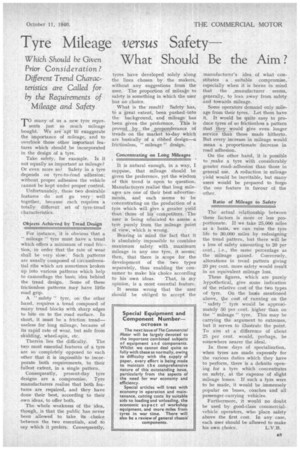Tyre Mileage versus Safety —
Page 21

If you've noticed an error in this article please click here to report it so we can fix it.
What Should Be the Aim ?
Which Should be Given Prior Consideration? Different Trend Characteristics are Called for by the Requirements of
Mileage and Safety
TO many of us a new tyre repre sents just so much mileage bought. We are apt to exaggerate the importance of mileage, and to overlook those other in/portant features which should be incorporated in the design of a tyre.
Take safety, for example. Is it not equally as important as mileage? Or even more so? Safety in a tyre depends on tyre-to4oad adhesion; without proper adhesion the vehicle cannot be kept under proper control.
Unfortunately, these two desirable features do not go very well• together, because each requires a totally different set of tyre-tread characteristics.
Objects Achieved by Tread Design For instance, it is obvious that a " mileage" tyre must have a tread which offers a minimum of road fric-. lion, in order that the rate of wear shall be very slow. Such patterns are usually composed of circumferential ribs which are sometimes broken up into various patterns which help to camouflage the basic idea behind the tread design. Some of these frictionless patterns May have little road grip.
A " safety " tyre, on the other hand, requires a tread composed of many tread blocks with sharp edges to bite on to the road surface. In short, it must be a friction tread— useless for long mileage, because of its rapid rate of wear, but safe from skidding, wheel-spin, etc.
Therein lies the difficulty. The two most essential features of a tyre are so completely opposed to each other that it is impossible to incorporate both requirements, to their fullest extent, in a single pattern.
Consequently, present-day tyre designs are a compromise. Tyre manufacturers realize that both features are required, and they have done their best,' according to their own ideas, to offer both.
The whole weakness of the idea, though, is that the public has never been allowed to take its choice between the two essentials, and to say which it prefers. Consequently, tyres have developed solely along the lines chosen by the makers, without any suggestions from the user. The proportion of mileage to safety is something in which the user has no choice.
What is the result? Safety has, to a great extent, been pushed -into the background, and mileage has been given the preference. This is proved by the ,preponderance of treads on the market to-day which are basically of a ribbed design—a frictionless, " mileage " design.
Concentrating on Long Mileages
It is natural enough, in a way, I suppose, that mileage should be given the preference, yet the wisdom of this trend is open to question. Manufacturers realize that long mileages are one of their best advertisements, and each seems to be concentrating on the production of a tyre which will give a greater yield :than those of his competitors. The user is being educated to assess a tyre purely from the mileage point of view, which is wrong.
Bearing in mind the fact that it is absolutely impossible to combine maximum safety with maximum mileage in any one tyre, it seems; then, that there is scope for the development of the two types separately, thus enabling the consumer to make his choice according to his own ideas. That, in my opinion, is a most essential feature. It seems wrong that the user should be obliged to accept the manufacturer's idea of what constitutes a suitable compromise, especially when it is borne in mind that the .manufacturer seems, generally, to lean away from safety and towards mileage.
Some operators demand only mileage from their tyres. Let them have it. It would be quite easy to produce tyres of so frictionless a pattern that they would give even longer service than those made hitherto. But every increase in mileage would mean a proportionate decrease in road adhesion.
On the other band, it is possible to ,make a tyre with considerably greater road..adhesion than those in general use. A reduction in mileage yield would be inevitable, but many users would be prepared to forgo the one feature in favour of the other.
Ratio of Mileage to Safety
The actual relationship between -these factors is more or less proportionate. If we take 25,000 miles as a basis, we can raise the tyre life to 30,000 miles by redesigning the tread pattern, but there will be a loss of safety amounting to 20 per cent., i.e., the same percentage as the mileage gained. Conversely, alterations in tread pattern giving 20 per cent. more safety would result in an equivalent mileage loss.
These figures, which are purely hypothetical, give some indication of the relative cost of the two types of tyre. On the basis mentioned above, the cost of running on the " safety " tyrb would be approximately 50 per cent. higher than on the " mileage " tyre. This may be carrying the argument to extremes, but it serves to ilhistrate the point. To aim at a difference of about 25 per cent, would, perhaps, be somewhere nearer the ideal.
In these days of specialization, when tyres are made expressly for the various duties which they have to perform, there is a definite opening for a tyre which concentrates on safety, at the expense of slight mileage losses. If such a tyre were to be made, it would be immensely popular on buses, coaches and all passenger-carrying vehicles.
Furthermore, it would no doubt be used by good-class commercialvehicle operators, who place safety above the first cost. In any case, each user should be allowed to make his own choice. L.V.B.




















































